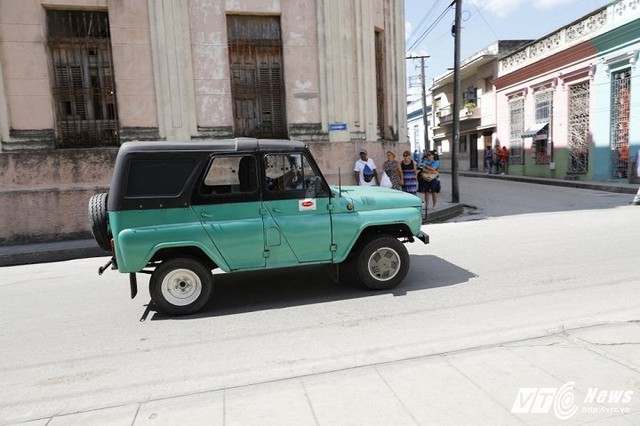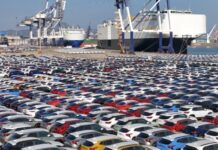Every province in Cuba has a vintage car club. These clubs gather the oldest and most original cars, just as they were when they left the factory. Currently, these clubs are preserving a unique collection of vintage cars that is unmatched by any other country in the world, including the famous 1905 Cadillac known as the “national treasure”.
Most cars in Cuba are from the 1930s, 1940s, and 1950s, manufactured by the United States. About 30% of cars are Soviet cars (used), and there are also a few modern cars.
Permission is required to repair vintage cars
The management of these clubs falls under the purview of the Havana City Historical Office. This office has the authority to grant or deny permission to repair or replace parts for vintage cars, and trading of vintage cars is strictly forbidden.
The vintage car club currently manages 431 cars (as of 2008). On Sunday mornings, the club organizes vintage car parades in Havana. Members of the club must adhere to a principle – if they wish to repair or replace any parts, they must submit a request and obtain approval.
Given the difficulty in finding parts for vintage cars, as there are no longer any manufacturers producing such parts, the process of replacing a part for a vintage car is lengthy and labor-intensive.
One interesting aspect of Cuba is that owning a car essentially makes you a mechanic. Cars are considered valuable assets in Cuban society, and people invest a significant amount of money and effort into their vehicles.
Many cars in Cuba may have a vintage appearance, but their engines are modern, such as Hyundai, Mitsubishi, or Toyota. Additionally, many car owners opt to install diesel engines due to their economic efficiency and availability on the black market.
However, a car from the 1950s produced in the United States never sells for less than $5,000, while Russian cars are slightly more expensive, starting from $7,000. Almost every Cuban family owns a car.
Cars as a source of income
In Cuba, cars are not just a means of transportation but also a major source of income for many families. People often rent out their cars for interprovincial trips, charging between $40 and $60 per day. This allows them to earn nearly $2,000 per month, a significant amount for the majority of Cubans. Additionally, many individuals work as taxi drivers in the evenings.
Due to limited economic opportunities, even individuals with higher education levels who work at universities or large hospitals may work as taxi drivers in the evenings. This occupation provides them with a considerable income, sometimes several times higher than their official salary.

Soviet U-boat cars are highly popular among Cuban government agencies. Photo: Phong Son
Anyone who has studied in Cuba will never forget the experience of riding a bus. Some people may criticize it, but many consider it an interesting part of life.
In Cuba, there are two main types of public transportation – buses and coaches. Coaches are primarily privately owned, and in recent years, the government has taken measures to regulate these vehicles, ensuring fair pricing and passenger safety.

Lam car – the preferred means of public transport in suburban provinces. Photo: Phong Son
Most interprovincial buses in Cuba are inexpensive, used vehicles, many of which have been repaired. To purchase a bus ticket, you must register about two weeks in advance. Sometimes, you may have a reservation but still be unable to purchase a ticket on the day of travel.
Therefore, many people choose to buy black market tickets or travel by coach, which costs a bit more but guarantees a seat. Nonetheless, most people prefer to take the bus as it offers a more comfortable experience.
Cities in Cuba have diverse bus options. Buses are widely used by Cuban people, and while buses may be crowded, there is no pushing or shoving at bus stops. In larger cities, double-decker buses are available, custom-made to accommodate several hundred passengers. These buses are named “double-decker” due to a raised rubber pipe in the middle that resembles a camel with two humps.
Private coaches offer the advantage of speed and convenience, as drivers are willing to pick up passengers directly at their doorstep. However, these coaches are often uncomfortable. Not all coaches have air conditioning, and despite being designed to seat only four passengers, drivers often squeeze in six individuals. If all passengers are slim, it’s still manageable, but with larger individuals, it can be quite challenging.
A distinct aspect of Cuban and Latin American countries is that drivers often open their windows and play loud music. Many foreign students are initially not accustomed to this, but over time, they grow to appreciate it. They even miss the music when it’s absent. Inside many cars, the interiors are “modified” to resemble dance floors with various lights and screens.
In Cuba, traffic jams are virtually non-existent, and there is no speeding, reckless overtaking, or swerving like in Vietnam. This is due to the strict adherence to traffic regulations by the Cuban people.
Cubans strictly follow traffic rules, and traffic police primarily focus on inspecting suspicious vehicles rather than stopping cars for speeding. There is no corruption when dealing with the police. If you commit an offense, you will receive a ticket and must pay the fine at the nearest police station. More severe offenses may result in your driver’s license being marked.
Traffic police in Cuba are highly disciplined, and the Cuban Ministry of Internal Affairs’ Traffic Police Department has implemented an effective management policy to combat corruption. When a police officer issues an order to stop a car, they must call the central station and announce, “I have stopped the car with license plate number… The driver’s name is…”
At the central station, the on-duty officer immediately provides information about the car and driver, and the police officer issuing the order must state the reason for the stop and the punishment imposed.
It is also worth mentioning Cuba’s urban planning – all cities are built in a spacious and convenient chessboard pattern that minimizes congestion. In the heart of the capital city, La Habana, there is a large road that runs the entire length of the city. When traveling on this road, cars must maintain speeds of 60 to 100 km/h.
Hitchhiking is uncommon
The people of Cuba have a unique tradition of hitchhiking. You can stop at any well-trafficked location, typically at a red light, and ask for a ride to a specific destination. No money is exchanged, and if convenient, drivers will open their doors and give you a lift. Most individuals who hitchhike are students from other provinces or people who work but lack their own transportation.
Interestingly, hitchhiking culture emerged in the 1990s. When the Soviet Union collapsed, gasoline supplies to Cuba were severely disrupted, leading to numerous difficulties. In response, the Cuban government mandated that all drivers, particularly those operating public vehicles, must give rides to fellow travelers headed in the same direction. Traffic police even set up “ambushes” to apprehend drivers who refuse to offer rides. Over time, hitchhiking has evolved into a unique traffic culture that sets Cuba apart.
Currently, not only Cuban citizens but also foreign residents with a residence permit or foreigners working in Cuba are allowed to freely buy and sell cars and motorcycles. However, given the current prices, many people may find it challenging to afford the car they desire.
For instance, at a state-owned showroom specializing in selling Peugeot cars in the capital city of La Habana, a 2013 Peugeot Expert Tepee car is priced at over $220,000. In Europe, this car is sold for just 20,000 Euros.
The opening of the private car market represents a significant step for the Cuban government in developing the economy and creating opportunities for individuals to become self-employed. However, the current opening is still in the trial phase, with only a few locations allowing private car sales. Additionally, revenue generated from car sales will be used to develop public transportation.
Cuba is currently facing a severe energy crisis due to political and economic instability in Venezuela, one of Cuba’s loyal allies. Under an agreement between the two countries, Venezuela was supposed to supply Cuba with 120,000 barrels of oil per day, while Cuba would send doctors, teachers, and engineers in return.
Recently, the Cuban government had to implement stricter energy consumption measures throughout the country. Power outages occur systematically in residential areas, factories, and businesses. Additionally, a rule was enacted that only tourist cars are allowed to purchase A95 gasoline.
These factors may lead to the complete replacement of all vehicles that are too old and consume excessive amounts of fuel and oil. However, this would greatly impact the lives of the Cuban people, as the country’s budget is already quite limited and unable to import a large number of cars.
Given the challenging current situation, opening up to Cuba represents a real challenge, especially in light of new policies introduced by US President Donald Trump. How will the Cuban government navigate these difficult circumstances, considering the increasingly unstable economic and political climate in the world and Latin America?




































